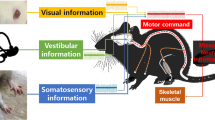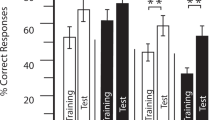Abstract
When a subject is walking blindfolded straight ahead towards a previously seen target, the brain must update an internal representation with respect to the environment. This study examines whether the information given by the vestibular system is necessary for this simple path integration task and gives a quantitative description of locomotor behaviour during the walk by comparing ten normal and seven bilateral labyrinthine-defective (LD) subjects. Each subject performed 20 blindfolded walks (EC) and ten walks with eyes open (EO) towards a target attached to the floor 4 m in front of them; these walks were made at different velocities. The positions of head, trunk and feet were recorded using a 3D motion analysis system. No significant difference was found between normal and LD groups in terms of the distance error of reaching the target, while LD subjects showed a larger lateral error. Path curvature, expressed as the standard deviation of the angle between the direction of one step and straight ahead, was found to be significantly larger for LD subjects in the EC condition, demonstrating their instability when walking without vision. Mean walking velocity was lower for LD subjects than for normal subjects in both EC and EO conditions. Both groups walked faster with eyes open; LD subjects increased their velocity by increasing step length, normal subjects by increasing step frequency. Head stabilisation in the frontal plane during locomotion was not significantly different between LD and normal subjects, whereas both head and trunk rotation were slightly larger in LD subjects during blindfolded walking. The results show that bilateral LD subjects are able to perform linear goal-directed locomotion towards memorised targets. Thus, the vestibular system does not appear to be necessary for active linear path integration.
Similar content being viewed by others
References
Beritoff JS (1965) Spatial orientation in man. In: Liberson WT (eds) Neural mechanisms of higher vertebrate behaviour. Little Brown, Boston, pp 137–157.
Berthoz A, Pozzo T (1988) Intermittent head stabilization during postural and locomotory tasks in humans. In: Amblard B, Berthoz A, Clarac F (eds) Development, adaptation and modulation of posture and gait. Elsevier, Amsterdam pp 189–198.
Corlett JT (1986) The effect of environmental cues on locomotor distance estimation by children and adults. Human Mov Sci 5:235–248.
Corlett JT, Byblow W, Taylor B (1990) The effect of perceived locomotor constraints on distance estimation. J Motor Behav 22:347–360.
Elliot D (1987) The influence of walking speed and prior practice on locomotor distance estimation. J Motor Behav 19:476–485.
Etienne AS, Teroni E, Maurer R, Portenier V, Saucy F (1985) Short-distance homing in a small mammal: the role of exteroceptive cues and path integration. Experimentia 41:121–125.
Ferrandez AM, Pailhous J, Durup M (1990) Slowness in elderly gait. Exp Aging Res 16:79–89.
Glasauer S, Amorim MA, Pawlowa O, Berthoz A (1993a) Linear path integration during locomotion. I. Normal subjects. Proceedings of the XVII. Barany Society Meeting, Prague, 1992, pp 57–60.
Glasauer S, Amorim MA, Vitte E, Berthoz A (1993b) Linear path integration during locomotion. II. Labyrinthine-defective subjects. Proceedings of the XVII. Barany Society Meeting, Prague, 1992, pp 61–64.
Gresty MA, Bronstein AM (1992) Visually controlled spatial stabilization of the human head: compensation for the eye's limited ability to roll. Neurosci Lett 140:63–66.
Grieve DW, Gear RJ (1966) The relationship between length of stride, step frequency, time of swing and speed of walking for children and adults. Ergonomics 5:379–399.
Grossman GE, Leigh RJ (1990) Instability of gaze during locomotion in patients with deficient vestibular function. Ann Neurol 27:528–523.
Guedry FE, Stockwell CW, Norman JW, Owens GG (1971) The use of triangular waveforms of angular velocity in the study of vestibular function. Acta Otolaryngol 71:439–448.
Israël I, Berthoz A (1989) Contribution of the otoliths to the calculation of linear displacement. J Neurophysiol 62:247–263.
Klatzky R, Loomis JM, Golledge RG, Cicinelli CG, Doherty S, Pellegrino JW (1990) Acquisition of route and survey knowledge in the absence of vision. J Motor Behav 22:19–43.
Laurent M, Thomson JA (1988) The role of visual information in control of a constrained locomotor task. J Motor Behav 20:17–37.
Loomis JM, Da Silva JA, Fujita N, Fukusima SS (1992) Visual space perception and visually-directed action. J Exp Psychol Hum Percep Perform 18:906–921.
Metcalfe T, Gresty M (1992) Self-controlled reorienting movements in response to rotational displacements in normal subjects and patients with labyrinthine disease. Ann NY Acad Sci 656:659–698.
Mittelstaedt H (1985) Analytical cybernetics of spider navigation. In: Barth FG (eds) Neurobiology of arachnids. Springer, Berlin Heidelberg, New York, pp 298–316.
Mittelstaedt H, Mittelstaedt M (1973) Mechanismen der Orientierung ohne richtende Außenreize. Fortschr Zool 21:46–58.
Mittelstaedt H, Mittelstaedt M (1980) Homing by path integration in a mammal. Naturwissenschaft 67:566.
Mittelstaedt ML, Glasauer S (1991) Idiothetic navigation in gerbils and humans. Zool Jb Physiol 95:427–435.
Mittelstaedt ML, Glasauer S (1993) Contribution of inertial and substratal information to the perception of linear displacement. Proceedings of the XVII. Barany Society Meeting, Prague, 1992, pp 102–105.
Müller M, Wehner R (1988) Path integration in desert ants, Cataglyphis fortis. Proc Natl Acad Sci USA 85:5287–5290.
Miyata H, Takashi T, Yatsuji I (1989) Gait disturbances in patients with labyrinthine and cerebellar diseases. Acta Otolaryngol [Suppl 468]:181–185.
Nilsson J, Thorstensson A (1987) Adaptability in frequency and amplitude of leg movements during human locomotion at different speeds. Acta Physiol Scand 129:107–114.
Pailhous J, Bonnard M (1992) Locomotor automatism and visual feedback. In: Proteau L, Elliot D (eds) Vision and motor control. Elsevier, Amsterdam, pp 399–419.
Potegal M (1982) Vestibular and neostriatal contributions to spatial orientation. In: Potegal M (eds) Spatial abilities. Academic Press, London, pp 361–387.
Pozzo T, Berthoz A, Lefort L (1991a) Head stabilization during various locomotor tasks in humans. I. Normal subjects. Exp Brain Res 82:97–106.
Pozzo T, Berthoz A, Lefort L, Vitte E (1991b) Head stabilization during various locomotor tasks in humans. II. Patients with bilateral peripheral vestibular deficits. Exp Brain Res 85:208–217.
Pozzo T, Levik Y, Berthoz A (1992) Head stabilization in the frontal plane during complex equilibrium tasks in humans. In: Woollacott M, Horak F (eds). Posture and gait: control mechanisms, vol I. XIth International Symposium of the Society for Postural and Gait Research. University of Oregon Books, Portland, pp 97–100.
Rieser JJ, Ashmead DH, Pick HL (1988) Perception of walking without vision: uncoupling proprioceptive and visual flow. Paper presented to the Psychonomic Society, Chicago, Illinois.
Rieser JJ, Ashmead DH, Talor CR, Youngquist GA (1990) Visual perception and the guidance of locomotion without vision to previously seen targets. Perception 19:675–689.
Taga G, Yamaguchi Y, Shimizu H (1991) Self-organized control of bipedal locomotion by neural oscillators in unpredictable environment. Biol Cybern 65:147–159.
Thomson JA (1980) How do we use visual information to control locomotion? Trends Neurosci 3:247–250.
Thomson JA (1983) Is continuous visual monitoring necessary in visually guided locomotion? J Exp Psychol 9:427–443.
Thorndyke PW, Hayes-Roth B (1982) Differences in spatial knowledge acquisition and navigation. Cogn Psychol 14:560–589.
Worchel P (1952) The role of the vestibular organs in space orientation. J Exp Psychol 44:4–10.
Author information
Authors and Affiliations
Rights and permissions
About this article
Cite this article
Glasauer, S., Amorim, M.A., Vitte, E. et al. Goal-directed linear locomotion in normal and labyrinthine-defective subjects. Exp Brain Res 98, 323–335 (1994). https://doi.org/10.1007/BF00228420
Received:
Accepted:
Issue Date:
DOI: https://doi.org/10.1007/BF00228420




